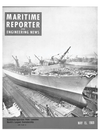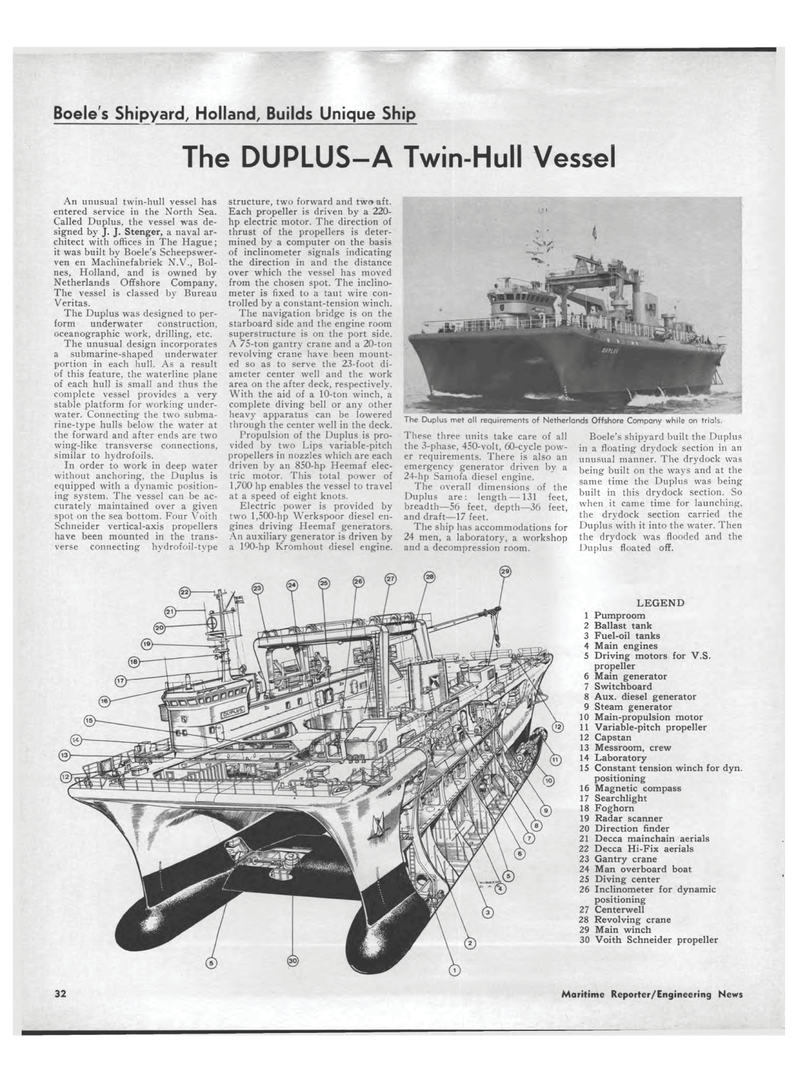
Page 28: of Maritime Reporter Magazine (May 15, 1969)
Read this page in Pdf, Flash or Html5 edition of May 15, 1969 Maritime Reporter Magazine
Boele's Shipyard, Holland, Builds Unique Ship The DUPLUS-A Twin-Hull Vessel An unusual twin-hull vessel has entered service in the North Sea. Called Duplus, the vessel was de-signed by J. J. Stenger, a naval ar-chitect with offices in The Hague; it was built by Boele's Scheepswer-ven en Machinefabriek N.V., Bol-nes, Holland, and is owned by Netherlands Offshore Company. The vessel is classed by Bureau Veritas. The Duplus was designed to per-form underwater construction, oceanographic work, drilling, etc. The unusual design incorporates a submarine-shaped underwater portion in each hull. As a result of this feature, the waterline plane of each hull is small and thus the complete vessel provides a very stable platform for working under-water. Connecting the two subma-rine-type hulls below the water at the forward and after ends are two wing-like transverse connections, similar to hydrofoils. In order to work in deep water without anchoring, the Duplus is equipped with a dynamic position-ing system. The vessel can be ac-curately maintained over a given spot on the sea bottom. Four Voith Schneider vertical-axis propellers have been mounted in the trans-verse connecting hydrofoil-type structure, two forward and two aft. Each propeller is driven by a 220-hp electric motor. The direction of thrust of the propellers is deter-mined by a computer on the basis of inclinometer signals indicating the direction in and the distance over which the vessel has moved from the chosen spot. The inclino-meter is fixed to a taut wire con-trolled by a constant-tension winch. The navigation bridge is on the starboard side and the engine room superstructure is on the port side. A 75-ton gantry crane and a 20-ton revolving crane have been mount-ed so as to serve the 23-foot di-ameter center well and the work area on the after deck, respectively. With the aid of a 10-ton winch, a complete diving bell or any other heavy apparatus can be lowered through the center well in the deck. Propulsion of the Duplus is pro-vided by two Lips variable-pitch propellers in nozzles which are each driven by an 850-hp Heemaf elec-tric motor. This total power of 1,700 hp enables the vessel to travel at a speed of eight knots. Electric power is provided by two 1,500-lip Werkspoor diesel en-gines driving Heemaf generators. An auxiliary generator is driven by a 190-hp Kromhout diesel engine. The Duplus met all requirements of Nether These three units take care of all the 3-phase, 450-volt, 60-cycle pow-er requirements. There is also an emergency generator driven by a 24-hp Samofa diesel engine. The overall dimensions of the Duplus are: length ?131 feet, breadth?56 feet, depth?36 feet, and draft?17 feet. The ship has accommodations for 24 men, a laboratory, a workshop and a decompression room. ids Offshore Company while on trials. Boele's shipyard built the Duplus in a floating drydock section in an unusual manner. The drydock was being built on the ways and at the same time the Duplus was being built in this drydock section. So when it came time for launching, the drydock section carried the Duplus with it into the water. Then the drydock was flooded and the Duplus floated off. LEGEND 1 Pumproom 2 Ballast tank 3 Fuel-oil tanks 4 Main engines 5 Driving motors for V.S. propeller 6 Main generator 7 Switchboard 8 Aux. diesel generator 9 Steam generator 10 Main-propulsion motor 11 Variable-pitch propeller 12 Capstan 13 Messroom, crew 14 Laboratory 15 Constant tension winch for dyn. positioning 16 Magnetic compass 17 Searchlight 18 Foghorn 19 Radar scanner 20 Direction finder 21 Decca mainchain aerials 22 Decca Hi-Fix aerials 23 Gantry crane 24 Man overboard boat 25 Diving center 26 Inclinometer for dynamic positioning 27 Centerwell 28 Revolving crane 29 Main winch 30 Voith Schneider propeller 32 Maritime Reporter/Engineering News

 27
27

 29
29
